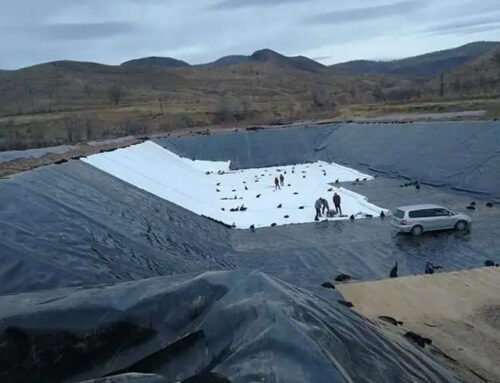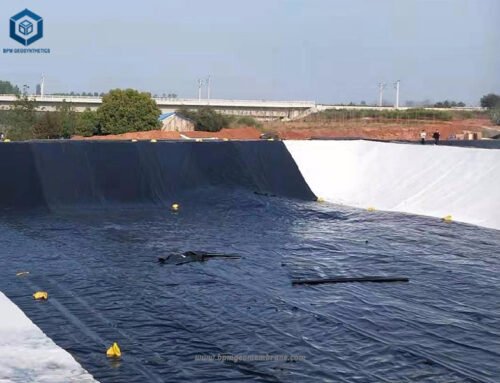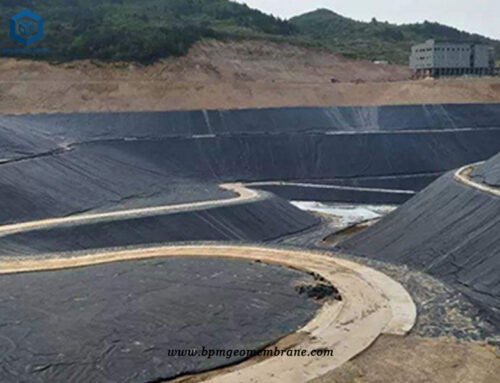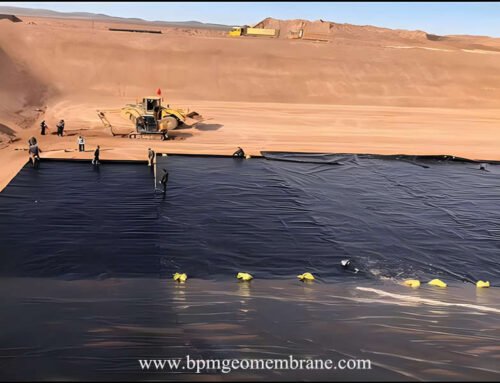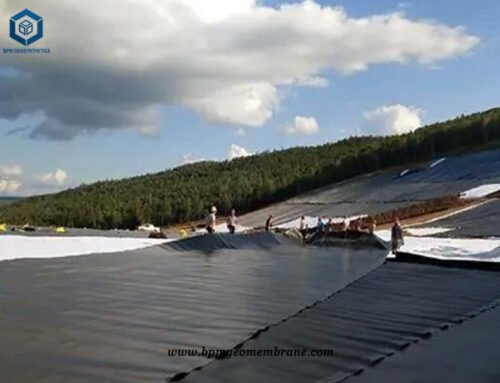A Smooth geomembrane HDPE liner is a type of geomembrane commonly used in various civil engineering and environmental applications. Geomembranes are thin, flexible sheets of material used to control the movement of fluids (such as water or gases) in geotechnical and environmental engineering applications. Smooth geomembrane HDPE liner is made of high-density polyethylene (HDPE) raw materials with carbon black, anti-aging agents, anti-ultraviolet absorbents, stabilizers and other auxiliary materials. HDPE geomembrane has good anti-leakage performance, excellent resistance to ultraviolet radiation, it is suitable for waterproof outdoor construction sites and is widely used in waste treatment, water treatment, aquaculture, industrial projects, energy projects and mining projects and other industries.
1. What Is Smooth Geomembrane HDPE Liner?
A smooth geomembrane HDPE liner is a thin and flexible sheet made from high-density polyethylene (HDPE) with a smooth surface texture. Geomembranes serve as a reliable barrier in applications that require containment and the prevention of fluid migration or seepage. The HDPE material used in these liners is known for its durability and impermeability.
Designed for various applications, smooth geomembrane HDPE liners provide an effective solution for projects such as landfill lining, mining ponds, and wastewater treatment facilities. The smooth surface texture of these liners offers advantages such as easy installation, efficient welding or seaming, and a low interface friction that resists shifting or sliding. With their ability to prevent fluid migration and their durability, smooth geomembrane HDPE liners play a crucial role in ensuring the integrity and effectiveness of containment systems.
2. What Are Smooth Geomembrane HDPE Liner Features?
2.1 Chemical Resistance
HDPE liners exhibit excellent resistance to a wide range of chemicals, making them highly suitable for applications where exposure to various substances is a concern.
2.2 UV Resistance
These liners possess good resistance to ultraviolet (UV) radiation, ensuring increased durability and longevity when used in outdoor applications.
2.3 Flexibility
HDPE liners are known for their flexibility, allowing them to conform to the shape of the underlying terrain and effectively contain liquids or substances.
2.4 HDPE Liner Installation
Proper installation is critical for the effectiveness of HDPE liners. Trained professionals typically handle the installation process, utilizing specialized welding techniques to create seams that are watertight and secure.
2.5 Smooth Geomembrane HDPE Liner Thickness
The thickness of HDPE liners can vary depending on the specific application and requirements. Thicker liners are often employed in scenarios where additional strength and puncture resistance are necessary.



3. Problems Caused by Gold Mine Tailings
With the fast demand for mineral products, the scale of mining development will increase accordingly, and the quantity of beneficiation tailing produced will continue to increase; In addition, the grade of many available metal ore is decreasing. In order to meet the increasing demand for mineral products. As the number of beneficiation tailings becomes larger and larger, the number of beneficiation tailings produced will also greatly increase, and a large amount of tailings piled up will cause many for mining, environment problems.
The stockpiled tailings occupies a lot of land and the stockpiling investment is huge. Regarding the treatment of tailings at home and abroad, regardless of whether the useful minerals in the tailings have recovery value, they are mostly stored on the ground. The stockpiling of tailings not only occupies a large amount of arable land, but also easily causes environmental pollution, soil erosion, and vegetation destruction in the mining area.
The impact of tailings on the natural ecological environment is specifically manifested as followed.
- When the tailings are piled, they are easy to flow and collapse,thencause vegetation damage and injury accidents. In the rainy season, the collapse and landslides will occur. The dam body of the tailings pond is relatively high and there are hidden dangers of insecurity.
- Tailings components and residual beneficiation reagents cause serious damage to the ecological environment, especially tailings containing heavy metals, where sulfide produces acidic water and further leaches heavy metals, and its loss will cause harm to the entire ecological environment.
Case Study of Smooth Geomembrane HDPE Liner South Africa for Mine Tailings Project
A South African customer wanted to buy HDPE geomembrane liners and geosynthetic products for a tailings anti-seepage project. BPM suggested two types of geomembranes: 1.0 mm smooth HDPE for the bottom and 1.5 mm textured HDPE for steep slopes. We sent samples, certificates, and test reports. The customer was pleased with our products. Four weeks later, we supplied 37,240 sq.m of 1.5 mm smooth HDPE and 10,150 sq.m of 2.0 mm rough HDPE to the customer. South Africa has large mining resources and a growing demand for minerals. As ore quality declines and beneficiation plans扩大, tailings increase. These tailings cause mining, environmental, and economic issues.

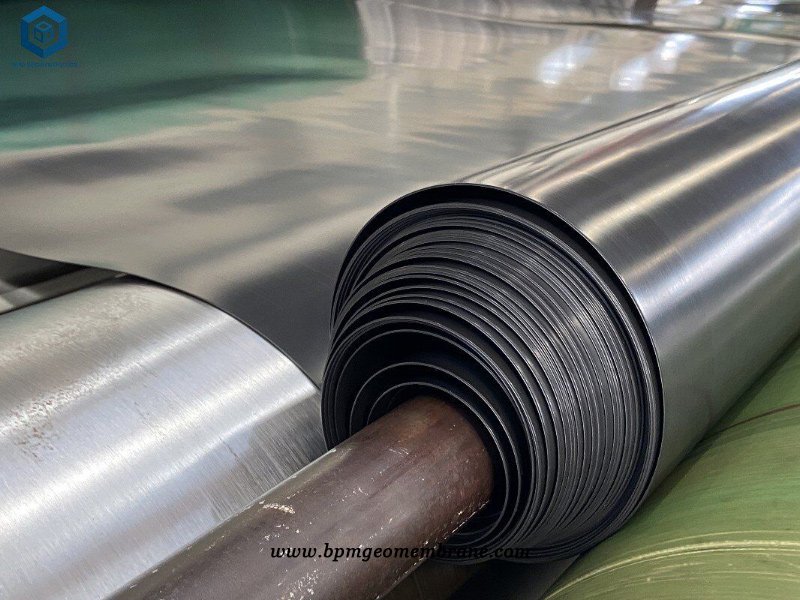

4. What Are Benefits of Smooth Geomembrane HDPE Liner For Tailings Treatment?
Tailings contain valuable substances but also final tailings that cannot be reprocessed. The sulfide in tailings produces acidic water and leaches heavy metals, damaging the soil and ecosystem if not properly managed. Improper storage can cause flowing and collapsing, especially in the rainy season, leading to collapses and landslides. Hazardous substances in tailings contaminate soil, causing salinization and poisoning. Soil pathogens can make people sick, and infiltration can contaminate pipes, entering the food chain and harming humans. There are high dams in tailings ponds with hidden dangers. Improper storage can cause damage and injury, particularly in the rainy season, leading to collapses and landslides. It may also cause environmental pollution, soil erosion, and damage in mining areas.
Approach
At present, the treatment method of tailings is generally used as filling material in the goaf of underground mining, that is, water-sand filling or cemented filling aggregate; or some are directly covering the tailings accumulation site to create land, planting crops or planting trees afforestation. In fact, the most economical treatment method of tailings is to make sand from tailings and as raw materials for building materials. For example, the treated tailings can be used as cement, tile, aerated concrete, permeable bricks, refractory materials, fireproof insulation materials, glass, As raw materials such as ceramsite and concrete aggregate, tailings sand can replace part of the machine-made sand to make concrete, build roads, and pavement materials.
When the tailings contain toxic or radioactive substances or heavy metal ions, in principle, it is not allowed to contain harmful substances to pollute the groundwater, so the leakage treatment should be done.
5. About BPM
As the the professional geomembrane manufacturer and supplier, BPM Geomembrane has been dedicated to supplying one stop geomembranes and services to worldwide customers since its foundation in 2010. Our main innovative, high quality geosynthetics products include geomembranes, geotextiles, geocells, geosynthetic clay liners (GCLs), drainage boards, geogrids, etc. Our geomembrane products have been exported to over 81 countries.
If you have any questions or inquiries, please contact us.

